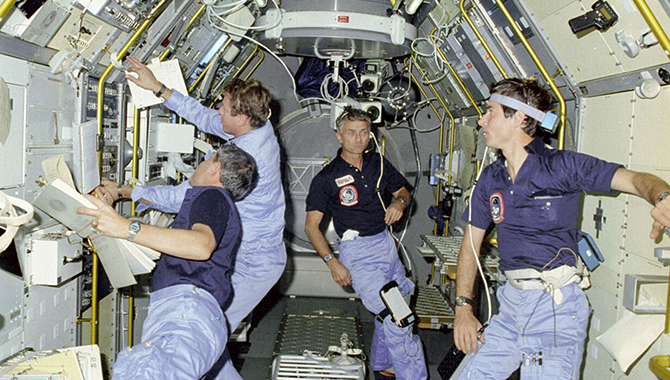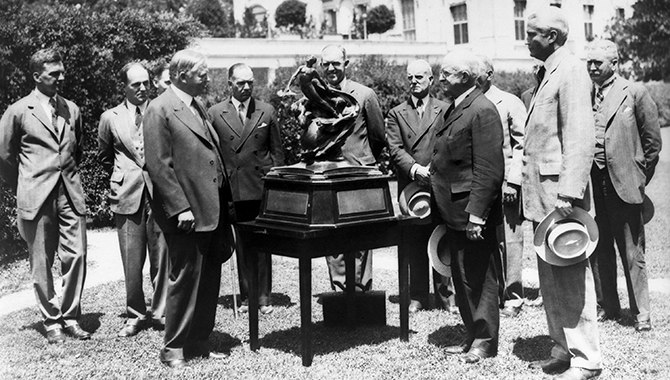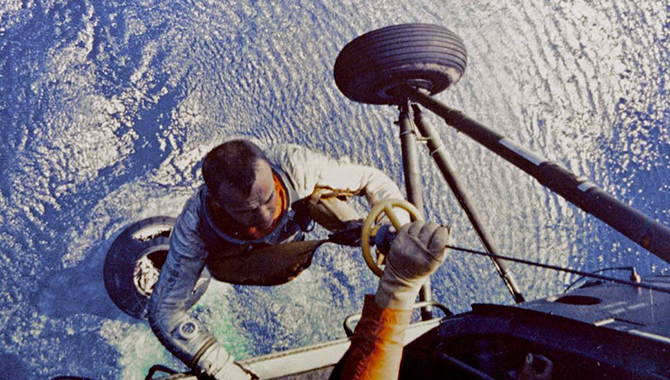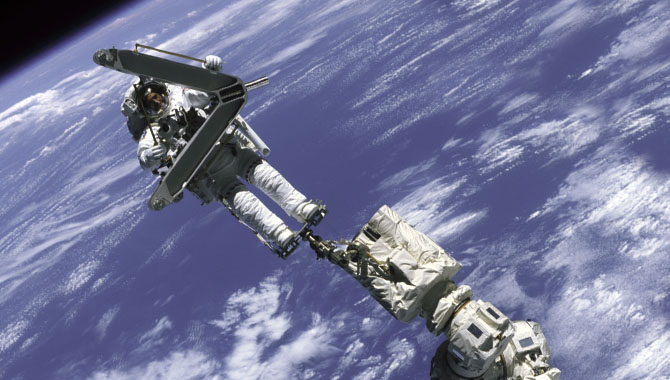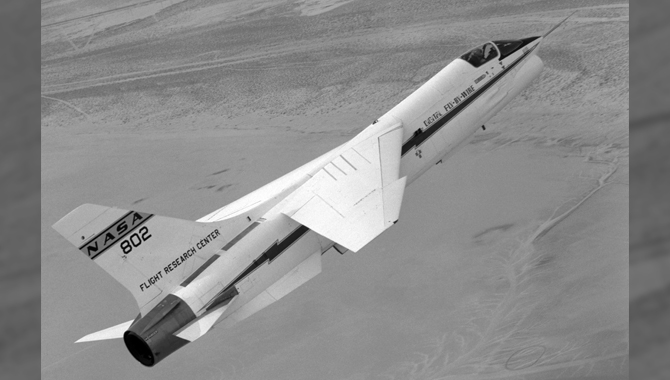
A Chance Vought F-8 Crusader, seen here in flight, was modified for NASA’s groundbreaking Digital Fly-By-Wire program.
Photo Credit: NASA
Forty-four years ago, NASA replaced the flight control system on an F-8C Crusader with a computer from the Apollo Program and sent the aircraft soaring into the sky.
A flight control system is like an aircraft’s brain: it links impulses or input from the pilot to the moveable parts of an aircraft that dictate how the plane climbs, banks, and descends. Originally, flight control systems were mechanical constructs made up of wires, cables, pulleys, and rods. Later augmented by hydraulics, they directly connected the pilot’s control stick and rudder pedals with control surfaces on the aircraft’s wings and tail so the pilot could maneuver the plane.
These mechanical flight control systems had significant drawbacks. First, they were heavy and bulky. They added to the size and weight of the aircraft, making it slower and less fuel efficient. Second, the direct link between pilot and control surfaces necessitated an inherently stable aircraft: one that defaulted to level flight after pilot input. This was critical because human reflexes—even the quickest—are relatively slow to recognize and respond to changes in flight conditions. The need for stability constrained aircraft design, however, dictating the size, shape, and placement of elements such as the tail, fuselage, and wings. This design, in turn, impaired the maneuverability of a plane, making it harder for the pilot to handle. A problem for any pilot, it was especially a concern for those flying fighter planes, who needed the ability to execute swift, controlled movements to avoid enemy fire.
Engineers had long been interested in developing an electronic, computer-controlled system that could monitor and maintain the performance of an aircraft. Such a system would remove the physical connection between pilot and aircraft control surfaces. Instead, signals from the cockpit would be processed by a computer and transmitted along wires to actuators that controlled the corresponding aerosurfaces. In this way, the computer would interact with the aircraft through sensors, continually assessing and then addressing minute changes in aerodynamic conditions while simultaneously responding to pilot commands. This would allow engineers to design aircraft that were inherently unstable, making the planes easier to control and maneuver by pilots as computer-guided adjustments kept the vehicles stable.
That was the concept behind NASA’s Digital Fly-By-Wire (DFBW) program. It wasn’t the first attempt at developing a computerized flight control system. The agency had experimented with a computerized controller during the X-15 program, in which one of the three rocket planes was equipped with a Honeywell MH-96 adaptive flight control system (AFCS) featuring an analog computer with a mechanical backup system. The AFCS enhanced the plane’s handling, particularly during the challenging conditions of atmospheric reentry, but the system was never perfected. A decade later, the concept of a computerized system was taken several steps further for the Gemini and Apollo programs. In 1969, the Lunar Module piloted by Neil Armstrong during the Apollo 11 mission employed a digital computer-driven fly-by-wire system.
Despite the system’s utility, proven under the most extreme circumstances, it wasn’t until Armstrong became Deputy Associate Administrator for Aeronautics that NASA tested an all-electric, digital flight control system in an aircraft. Engineers at the agency’s Flight Research Center (now Armstrong Flight Research Center (AFRC)) outfitted an F-8C Crusader, originally built in 1958 but stripped down and modified for NASA’s purpose, with a computerized control system. They removed the plane’s mechanical cables, pulleys, and rods and replaced them with actuators and electrical wire, then added a digital computer left over from the Apollo Program. The Apollo Guidance Computer, which was reprogrammed with updated software to meet the specifications of the DFBW program and coupled with an inertial sensing unit, served as intermediary between the pilot’s input and the aircraft’s control surfaces. The digital computer was supplemented by a three-channel electric analog computer that would kick in if anything went wrong with the aircraft’s main “brain.”
The DFBW program’s flight control system grew out of the agency’s experience with previous fly-by-wire attempts but was distinct in one critical way: the F-8C did not have a mechanical backup system. If anything went wrong with the computers, the pilot had nothing to fall back on. Fortunately, everything went right. On May 25, 1972, a bright morning at Edwards Air Force Base, the maiden voyage of the DFBW program took place. Research pilot Gary Krier was in the cockpit. An experienced airman, Krier had spent hundreds of hours in the DFBW simulator. He took the aircraft up and down without incident: the first flight was a success.
The program as a whole was successful as well. Over the course of its 210 flights, the DFBW program established that an electronic flight control system coupled with a digital computer alleviates the drawbacks of a mechanical flight control system. It makes aircraft lighter, faster, easier to fly, more reliable, and more fuel efficient. Because there are fewer moving parts, the system is also easier and less expensive to maintain.
Technology from the DFBW program—which eventually evolved from using an Apollo computer to a triple-redundant digital flight control system—was quickly transferred both internally and externally. The military embraced the improved handling of DFBW and used it as the foundation for developing stealth technology that would not have been otherwise possible. The commercial aviation industry also benefited from DFBW, which made for smoother flights and easier handling as well as increased fuel efficiency and corresponding cost savings. Within NASA, the DFBW flight control system informed the avionics for the space shuttle and other spacecraft.
The final flight of the DFBW program took place on April 2, 1985. The F-8C Crusader has since been grounded, but its legacy lives on in virtually every spacecraft and commercial or military aircraft flown today.
Read Computers Take Flight: A History of NASA’s Pioneering Digital Fly-By-Wire Program.
Watch a video of the DFBW F-8 exploring pilot-induced oscillations.






